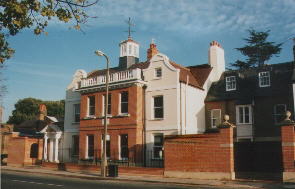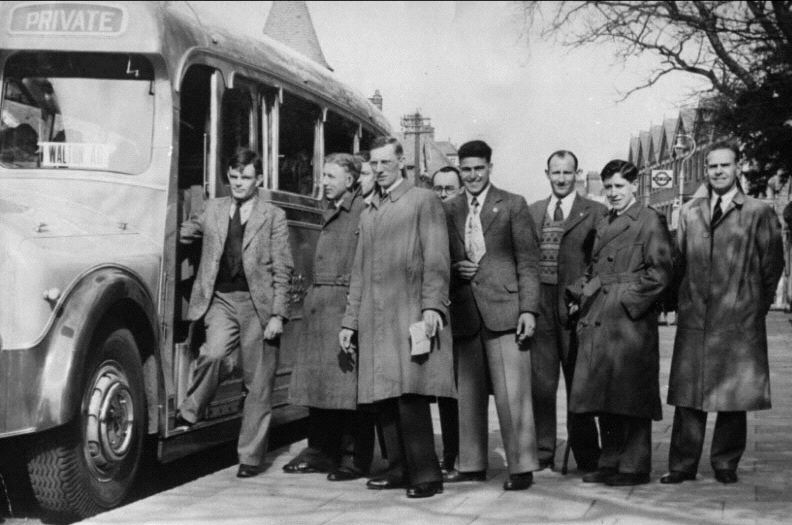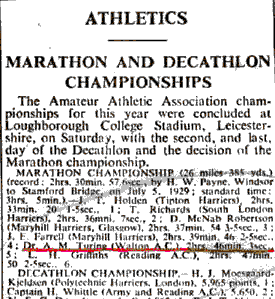Update to
|
Alan Turing: the Enigma |
| Page 317: The statement about AMT's lodgings is incorrect. His address was 78 High Street, Hampton; but I quite unjustifiably and incorrectly assumed that this was the High Street passing through Hampton Hill which borders the NPL site. In fact it was the High Street of old Hampton village, further away to the south-west. The lodging-house, Ivy House, was quite a superior establishment. (Photograph taken in 1990.) Streetmap here. A plaque marking AMT's period of residence there was unveiled on 2 December 2001. |  Ivy House, Hampton |
Page 345: One of my omissions in research was that I neglected to make contact with the secretary of the Walton Athletic Club, Mr J. F. 'Peter' Harding. Fortunately, in 1999 Mr Pat Butcher contacted Mr Harding and published two articles including anecdotes from Mr Harding, one in the (London) Financial Times, 15 May 1999, and one in Runners World, September 1999. They had the theme of AMT as a 'World Class Distance Runner'.

This photograph shows Alan Turing (on the bus steps) with other members of the Walton Athletic Club, an amateur club based in Walton, Surrey, an outer suburb of south-west London, not far from the National Physical Laboratory. The club members were probably on their way to a race meeting on a Saturday in 1946. The location is identifiable as Hersham Road, Walton. The figure at the front of the group, holding a piece of paper, is Ted Shepherd, a cross-country runner who was probably organising the transport for the meeting. Second from the right is his son Brian Shepherd, who would accompany Alan Turing to race meetings and pass him food at stages during long distance runs. This information comes from Mr Mike Saunders, who is Ted Shepherd's grandson, and recalls his grandfather speaking of Turing's high-carb training diet.
Mr Harding had in fact a number of excellent anecdotes about AMT's participation in the club. He explained that he had been invited to join the club after he was spotted running by himself in the local area (probably in late 1945). 'We heard him rather than saw him,' Mr Harding recalled. 'He made a terrible grunting noise when he was running, but before we could say anything to him, he was past us like a shot out of a gun. A couple of nights later we caught up with him long enough for me to ask who he ran for. When he said nobody, we invited him to join Walton. He did, and immediately became our best runner.'
'He was very popular with the boys, but he wasn't one of them. He was a strange character, a very reserved sort, but he mixed in with everybody quite well; he was even a member of our committee.
We had no idea what he did. We didn't even know where he worked until he asked us if Walton would have a match with NPL.
Another time, we went on our first-ever foreign trup, to Nijmegen in Holland. He couldn't come, but he gave me five pounds, which was a lot of money in those days, and said, " Buy the boys a drink for me." '
We never had any indication whatsoever [of his being gay.] There was our dressing room, with 20 or 30 young men, running around naked, darting in and out of the showers. He never approached one of them, invited them out for a drink or anything. But... we used to go on trips to London. We booked a show at the Prince of Wales theatre. There were dancing girls... Of course, the boys in the club, their eyes were bobbling out of their heads; they were all young lads. I looked across at Alan, and he was asleep.'
'I asked him one day why he punished himself so much in training. He told me, " I have such a stressful job that the only way I can get it out of my mind is by running hard." '
| Alan Turing achieved world-class Marathon standards. His best time of 2 hours, 46 minutes, 3 seconds, was only 11 minutes slower than the winner in the 1948 Olympic Games. In a 1948 cross-country race he finished ahead of Tom Richards who was to win the silver medal in the Olympics. |  From The Times, 25 August 1947 |
 AMT running in 1946 |
Page 370: Joan Murray (neé Clarke) thought it was possible that she did once spot AMT in the course of her work, at some point after these 1947 encounters. (She remained a full-time officer at GCHQ.) However, even if their paths did cross in this way, there was no actual meeting or talk. The only other contact was the letter AMT sent her in 1952 (page 465), which was also the year in which she married.
There is further material in the Alan Turing Internet Scrapbook: Alan Turing's Electronic Brain.
Update Index | Intro | Parts 1 | 2 | 3 | 4 | BP | 5 | 6 | 7 | 8 | Authors Note
| Quick Links: |
|
|
|
|
|
|
| |||